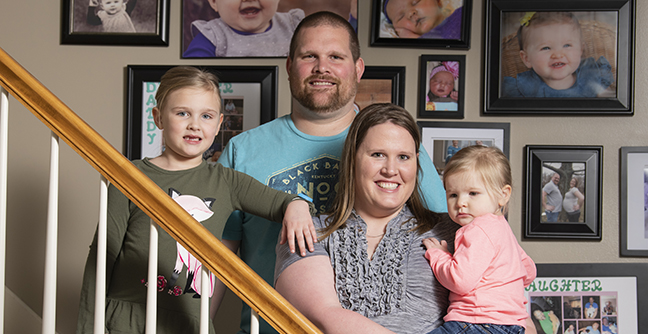As both a nurse and a mom, Allison Lee (pictured above with her family) of Gardner spends most of her time caring for her patients and her two young daughters, Harper and Nora. But when Allison started experiencing nausea and stomach pain after eating, she didn’t seek care for herself right away.
“I put it off for a long time,” Allison said. “But it kept getting worse. After six months of severe pain, I finally went to see my primary care doctor.”
Her doctor ordered an ultrasound and a pipida test—a special scan that evaluates how the gallbladder is functioning. The gallbladder is a small sac-like organ beneath the liver that collects bile, a digestive fluid that helps to break down fats during digestion.
Allison’s test results came back abnormal. Her primary care doctor, Keith T. Ratzlaff, MD, at Olathe Health Family Medicine – Olathe Medical Park, referred her to Elizabeth Long, MD, FACS, a board-certified surgeon with Olathe Health Midwest Surgical Associates.
“Allison’s gallbladder had stopped functioning properly, which was causing her pain. It was time to take it out.” Dr. Long said. “Humans can live healthy, normal lives without a gallbladder. Once it’s gone, the bile in the liver just goes directly into the small intestine.”
 Dr. Long (pictured left) performed the minimally invasive gallbladder removal—called a cholecystectomy—using a new robotic surgical system at Olathe Medical Center (OMC). During a robotic cholecystectomy, surgical instruments and a tiny camera are attached to robotic arms inserted into three or four tiny incisions. The surgeon controls the robotic arms to make small, precise movements inside the body.
Dr. Long (pictured left) performed the minimally invasive gallbladder removal—called a cholecystectomy—using a new robotic surgical system at Olathe Medical Center (OMC). During a robotic cholecystectomy, surgical instruments and a tiny camera are attached to robotic arms inserted into three or four tiny incisions. The surgeon controls the robotic arms to make small, precise movements inside the body.
The system also has a 3D high-definition (HD) vision system, special instruments and computer software that allows the surgeon to operate with enhanced vision, precision, dexterity and control. The 3D-HD image is highly magnified, providing a close-up view of the surgical area.
Another unique feature of robotic surgery at OMC is fluorescence imaging, which provides real-time, image-guided identification of key anatomical landmarks using near-infrared technology.
“With fluorescence imaging, we inject a special dye into the bloodstream. When it’s illuminated by a laser during surgery, the dye glows and shows a map of the bile duct,” Dr. Long said. “This helps us make better, more precise decisions during surgery.”
Allison’s surgery in late 2018 went as planned, and she went home that same day.
“I took it easy for two or three days, but after that I was back to normal and full-on mom duty. My stomach pain was gone right away,” Allison said.
She sticks to a low-fat diet and is slowly re-introducing foods that used to cause her pain, like salad and vegetables.
“Everyone in surgery was fantastic. They made sure I was well-informed going in, which eased my nerves,” she said. “It just feels good to feel good again.”
To learn more robotic surgery, visit olathehealth.org/roboticsurgery or call 913-791-4396.

